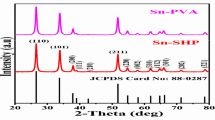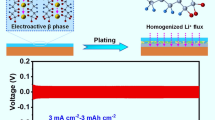Abstract
Nonaqueous electrolyte Li–air batteries with an O2-selective membrane at the cathode are developed for operation in ambient air at constant relative humidity (RH). The membrane allows for oxygen permeation and acts as a moisture barrier. Our group prepared highly hydrophobic films of poly(vinylidene fluoride co-hexafluoropropylene) (PVDF-HFP) via nonsolvent-induced phase separation. The addition of sacrificial silica nanoparticles (SiO2 NPs) to the precursor polymer solution increased the surface roughness of the casted membrane. Subsequent SiO2 NPs removal created a homogeneous porous network inside the membrane in which the silicone oil was trapped. The silicone oil accomplished the role of O2-selective medium. The Li–air cell with the oxygen-selective membrane forwarded capacities of 640 mA h g−1, at the discharge current density of 0.05 mA cm−2, in air (17 % RH). Under the same experimental conditions, but without the membrane at the cathode, the Li–air cell delivered a capacity of 220 mA h g−1. We demonstrate that the main cause of the unsatisfactory behaviour of the unprotected cell is the corrosion of the Li anode in the presence of water, although the cathode is also sensitive to CO2. The galvanostatic discharge–charge tests, in the capacity-controlled mode, confirmed the effectiveness of the membrane in protecting the Li–air cell in ambient air, assuring a cycle life comparable to that in dry oxygen atmosphere.
Graphical Abstract









Similar content being viewed by others
References
Lutz AC, McCloskey BD (2014) Nonaqueous Li–air batteries: a status report. Chem Rev 114:11721–11750
Ogasawara T, Debart A, Holzapfel M, Novàk P, Bruce PG (2006) Rechargeable Li2O2 electrode for lithium batteries. J Am Chem Soc 128:1390–1393
Girishkumar G, McCloskey B, Luntz AC, Swanson S, Wilcke W (2010) Lithium-air battery: promise and challenges. J Phys Chem Lett 1:2193–2203
Christensen J, Albertus P, Sanchez-Carrera RS, Lohmann T, Kozinsky B, Liedtke R, Ahmed J, Kojic A (2012) A critical review of Li/air batteries. J Electrochem Soc 159:R1–R30
Croy JR, Abouimrane A, Zhang Z (2014) Next-generation lithium-ion batteries: the promise of near-term advancements. MRS Bull 39:407–415
Sahapatsombut U, Cheng H, Scott K (2014) Modelling of operation of a lithium-air battery with ambient air and oxygen-selective membrane. J Power Sources 249:418–430
Padbury R, Zhang X (2011) Lithium-oxygen batteries-limiting factors that affect performance. J Power Sources 196:4436–4444
Crowther O, Salomon M (2012) Oxygen selective membranes for Li–air (O2) batteries. Membranes 2:216–227
Schwenke KU, Metzger M, Restle T, Piana M, Gasteiger HA (2015) The influence of water and protons on Li2O2 crystal growth in aprotic Li–O2 cells. J Electrochem Soc 162:A573–A584
Gowda SR, Brunet A, Wallraff GM, McCloskey BD (2013) Implications of CO2 contamination in rechargeable nonaqueous Li–O2 batteries. J Phys Chem Lett 4:276–279
Lim HK, Lim HD, Park KY, Seo DH, Gwon H, Hong J, Goddard WA, Kim H, Kang K (2013) Toward a lithium-air battery: the effect of CO2 on the chemistry of a lithium-oxygen cell. J Am Chem Soc 135:9733–9742
Wang H, Zhang WD, Deng ZQ, Chen MC (2009) Interaction of nitrogen with lithium in lithium ion batteries. Solid State Ion 180:212–215
Guo Z, Dong X, Yuan S, Wang Y, Xia Y (2014) Humidity effect on electrochemical performance of Li–O2 batteries. J Power Sources 264:1–7
Cho MH, Trottier J, Gagnon C, Hovington P, Clément D, Vijh A, Kim CS, Guerfi A, Black R, Nazar L, Zaghib K (2014) The effects of moisture contamination in the Li–O2 battery. J Power Sources 268:565–574
Zhang T, Zhou H (2013) A reversible long-life lithium-air battery in ambient air. Nat Commun 4:1–7
Zhang SS, Xu K, Read J (2011) A non-aqueous electrolyte for the operation of Li/air battery in ambient environment. J Power Sources 196:3906–3910
Zhang T, Zhou H (2012) From Li–O2 to Li–air batteries: carbon nanotubes/ionic liquid gels with a tri-continuous passage of electrons, ions, and oxygen. Angew Chem 124:11224–11229
Shao Y, Ding F, Xiao J, Zhang J, Xu W, Park S, Zhang JG, Wang Y, Liu J (2013) Making Li–air batteries rechargeable: material challenges. Adv Funct Mater 23:987–1004
Crowther O, Meyer B, Morgan M, Salomon M (2011) Primary Li–air cell development. J Power Sources 196:1498–1502
Zhang JG, Wang D, Xu W, Xiao J, Williford RE (2010) Ambient operation of Li/air batteries. J Power Sources 195:4332–4337
Zhang J, Xu W, Liu W (2010) Oxygen-selective immobilized liquid membranes for operation of lithium-air batteries in ambient air. J Power Sources 195:7438–7444
Zhang J, Xu W, Li X, Liu W (2010) Air dehydration membranes for nonaqueous lithium-air batteries. J Electrochem Soc 157:A940–A946
Fu Z, Wei Z, Lin X, Huang T, Yu A (2012) Polyaniline membranes as waterproof barrier for lithium air batteries. Electrochim Acta 78:195–199
Cao L, Lv F, Liu Y, Wang W, Huo Y, Fu X, Sun R, Lu Z (2015) A high performance O2 selective membrane based on CAU-1-NH2@polydopamine and PPM polymer for Li–air batteries. Chem Commum 51:4364–4367
Yuan J, Zhu Y, Gao J, Li W (2015) Electrochemical performance of mixed carbon material with waterproof membrane for lithium air battery in the ambient atmosphere. Energy 89:84–91
Stöber W, Fink A, Bohn E (1968) Controlled growth of monodisperse silica spheres in the micron size range. J Coll Int Sci 26:62–69
Kuo CY, Lin HN, Tsai HA, Wang DM, Lai JY (2008) Fabrication of a high hydrophobic PVDF membrane via nonsolvent induced phase separation. Desalination 233:40–47
Liu F, Hashim NA, Liu Y, Moghareh Abed MR, Li K (2011) Progress in the production and modification of PVDF membranes. J Membr Sci 375:1–27
Kurumada K, Kitamura T, Fukumoto N, Oshima M, Tanigaki M, Kanazawa S (1998) Structure generation in PTFE porous membranes induced by the uniaxial and biaxial stretching operations. J Membr Sci 149:51–57
Matsuyama H, Maki T, Teramoto M, Asano K (2002) Effect of polypropylene molecular weight on porous membrane formation by thermally induced phase separation. J Membr Sci 204:323–328
Yuan J, Liu X, Akbulut O, Hu J, Suib S, Kong J, Stellacci F (2008) Superwetting nanowire membranes for selective absorption. Nat Nanotechnol 3:332–336
Wang S, Li Y, Fei X, Sun M, Zhang C, Li Y, Yang Q, Hong X (2011) Preparation of a durable superhydrophobic membrane by electrospinning poly (vinylidene fluoride) (PVDF) mixed with epoxy-siloxane modified SiO2 nanoparticles: a possible route to superhydrophobic surfaces with low water sliding angle and high water contact angle. J Colloid Interf Sci 359:380–388
Pandey P, Chauhan RS (2001) Membrane for gas separation. Prog Polym Sci 26:853–893
Zeng J, Nair JR, Francia C, Bodoardo S, Penazzi N (2014) Aprotic Li–O2 cells: gas diffusion layer (GDL) as catalyst free cathode and tetraglyme/LiClO4 as electrolyte. Solid State Ion 262:160–164
Geaney H, O’Connell J, Holmes JD, O’Dwyer C (2014) On the use of gas diffusion layers as current collectors in Li–O2 battery cathodes. J Electrochem Soc 161:A1964–A1968
Assary RS, Lu J, Du P, Luo X, Zhang X, Ren Y, Curtiss LA, Amine K (2013) The effect of oxygen crossover on the anode of a Li–O2 battery using an ether-based solvent: insights from experimental and computational studies. ChemSusChem 6:51–55
McCloskey BD, Speidel A, Scheffler R, Miller DC, Viswanathan V, Hummelshøj JS, Nørskov JK, Luntz AC (2012) Twin problems of interfacial carbonate formation in nonaqueous Li–O2 batteries. J Phys Chem Lett 3:997–1001
Acknowledgments
Financial support for this study was provided by the European Union Seventh Framework Programme (FP7/2007-2013) project STABLE (n. 314508). The authors sincerely thank Dr. Giuseppina Meligrana for XRD and Mr. Mauro Raimondo for FESEM analyses.
Author information
Authors and Affiliations
Corresponding author
Electronic supplementary material
Below is the link to the electronic supplementary material.
Rights and permissions
About this article
Cite this article
Amici, J., Francia, C., Zeng, J. et al. Protective PVDF-HFP-based membranes for air de-hydration at the cathode of the rechargeable Li–air cell. J Appl Electrochem 46, 617–626 (2016). https://doi.org/10.1007/s10800-016-0951-3
Received:
Accepted:
Published:
Issue Date:
DOI: https://doi.org/10.1007/s10800-016-0951-3




